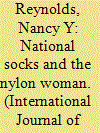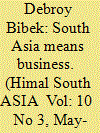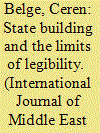| Srl | Item |
| 1 |
ID:
103466


|
|
|
|
|
| Publication |
2011.
|
| Summary/Abstract |
This article analyzes the exercise of state authority in Kurdish areas in the early Turkish Republic and discusses the state's ineffectiveness in dominating these areas. It argues that the mere existence of a highly ambitious social-engineering project, increased state presence in the region, and military power does not mean high levels of state capacity. Based on primary documents, this article discusses the problems of autonomy, coherence, and implementation that the Turkish state encountered in its nation-building project. It shows how the state's ideological rigidities and its shortage of resources and dedicated personnel undermined its capacity to control and shape the Kurdish areas. While the state attempted to regulate citizens' private lives in Kurdish areas, the local society also tried to mold state employees in accordance with its own interests. A blurred boundary between the state and society was one of the unintended consequences of increased state presence in everyday life.
|
|
|
|
|
|
|
|
|
|
|
|
|
|
|
|
| 2 |
ID:
103459


|
|
|
|
|
| Publication |
2011.
|
| Summary/Abstract |
This article examines the rise and fall of the Malhamé family at the court of Abdülhamit II. The point of departure is the flight and arrest of six Malhamé brothers and the accompanying outbursts of popular anger at them during the Young Turk Revolution of 1908. The analysis locates the historical conditions that made the Malhamé phenomenon possible in the interstices between Levantine society, late Ottoman bureaucracy, and European diplomacy and capitalist expansion. In order to bring into conversation the hitherto unconnected literatures on the Levant and the Ottoman state, the Malhamé story is framed in the analytical concept of transimperialism. This concept shares affinities with wider transnational studies. But it is also grounded in the specific political, economic, and social processes of the Levant-both within the Ottoman Empire and among it and its British, French, German, and Italian imperial rivals at the height of the "Eastern Question."
|
|
|
|
|
|
|
|
|
|
|
|
|
|
|
|
| 3 |
ID:
103464


|
|
|
|
|
| Publication |
2011.
|
| Summary/Abstract |
he specific ways that cloth-"foreign silks," "durable Egyptian cottons," and "artificial silks"-emerged as a potent and visible symbol through which to contest the relations of colonialism and establish national community in Egypt varied with the changing realities of Egypt's political economy. The country's early importation of textiles despite its cultivation of raw cotton, the growth of its state-protected local mechanized industry working long- and medium-staple cotton for a largely lower-class market, and that industry's diversification into artificial silk technologies all helped structure a shift from "foreign silks" to "the nylon woman" as tropes in popular and political discourse defining the limits of the national community and the behaviors suitable for it. Although artificial fibers considerably lowered the cost of hosiery and other goods, thereby expanding consumption, the use of synthetics like nylon rather than cotton subverted the goal of national economic unity between agriculture and industry.
|
|
|
|
|
|
|
|
|
|
|
|
|
|
|
|
| 4 |
ID:
103456


|
|
|
|
|
| Publication |
2011.
|
| Summary/Abstract |
European merchants and investors doing business in the Middle East during the long 19th century expected that commercial disputes in mixed cases would be conducted according to procedures and laws familiar to and accepted by them. In the Ottoman Empire and Egypt, mixed courts based on the French commercial code were established during that century. The Qajars, however, offered the foreign commercial community a different judicial institution: the local ka-rguza-r (agent) and his majlis (court). By the beginning of the 20th century, thirty-six ka-rguza-r offices operated in Iranian towns and harbors. Nevertheless, foreign (mainly British) merchants and their consuls complained bitterly that it was not an effective institution and that it clearly favored the local tujja-r (big merchants). They claimed that these defects meant huge financial losses to them. The Qajars viewed this institution and its functioning differently. It served their policy of discouraging foreign penetration, and it contributed to the competitiveness of the Iranian tujja-r in their struggle for commercial superiority.
|
|
|
|
|
|
|
|
|
|
|
|
|
|
|
|
| 5 |
ID:
011410


|
|
|
|
|
| Publication |
May-June 1997.
|
| Description |
20-23
|
|
|
|
|
|
|
|
|
|
|
|
|
|
|
|
| 6 |
ID:
103468


|
|
|
|
|
| Publication |
2011.
|
| Summary/Abstract |
When writing biographies of historical figures, narrative convention requires that concision and clarity be wrested from sources that are multiple and often confusing. In this article, I argue that multiple accounts of a person's life may be more than an accident arising from the way that information was compiled. Rather, such multiplicity renders exemplary figures adaptable to a wide variety of circumstances, making them even more useful as a focus of devotion and emulation. Examining multiple accounts of early Maliki scholar Sahnun b. Sa? id (d. 854), including those of his travels in search of knowledge and of his suffering under the mih.na (trial) in Kairouan, I find that close attention to apparently contradictory evidence may not get us any closer to understanding the man himself, but it does offer us much information about the ways in which he was considered an exemplary individual.
|
|
|
|
|
|
|
|
|
|
|
|
|
|
|
|